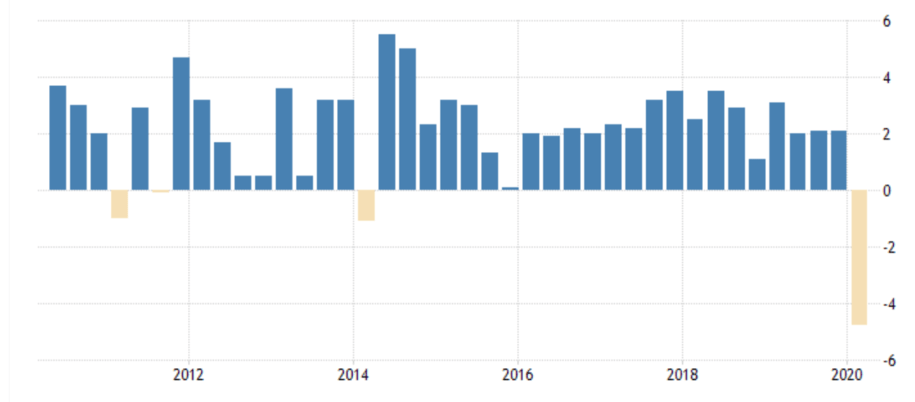[ad_1]
The BEA notes:
The decline in first quarter GDP was, in part, due to the response to the spread of COVID-19, as governments issued “stay-at-home” orders in March. This led to rapid changes in demand, as businesses and schools switched to remote work or canceled operations, and consumers canceled, restricted, or redirected their spending. The full economic effects of the COVID-19 pandemic cannot be quantified in the GDP estimate for the first quarter of 2020 because the impacts are generally embedded in source data and cannot be separately identified.
As has been the case with so many of the projections seen in the past month, what the immediate future will look like is highly speculative, with analysts all over the place. For instance, Bloomberg Economics is projecting a 37% annualized contraction of GDP, while UniCredit puts it at 65%. Unemployment rates are projected at 16% to 32%. Any of those outcomes would be devastating. But, with 26 million Americans having filed new claims for unemployment benefits in the past five weeks, nobody needs these GDP numbers to know the damage already is deep and wide and headed for rougher territory.
As usual, the structural economic inequality plaguing the nation will take a disproportionate toll on what some critics label the precariat—the most vulnerable Americans already barely making ends meet. GDP reports are not designed to show differential impacts.
For instance, a Brookings Institution report released in November noted in its analysis that 53 million Americans between the ages of 18 and 64 qualify as “low-wage.” That is 44% of all workers. Their median hourly wage? $10.22. Median annual earnings? About $18,000. Well above the $7.25 federal minimum that hasn’t changed in a decade and is worth $6.05 in 2020 dollars, which in no way is a living wage in most parts of the country. And that was the situation after a decade of economic growth. An economy that Donald Trump says he’s made the greatest in the world.
Despite the massive amount of COVID-19-related spending Congress has allocated to provide temporary economic relief for businesses and workers, millions are ineligible for these programs or have found the process slow and rickety. At the bank, small business owners have found themselves at a disadvantage against larger concerns when trying to obtain federally backed loans with their built-in repayment waivers.
Among the details of Wednesday’s GDP report:
- The steepest drop in consumer spending since 1980, falling at a 7.6% rate. (And 68% of GDP comes from consumer spending 23% in good and 45% in services.)
- The fastest decline in business investment since 2009
- Exports of services plummeted further than at any time since 1975
Treasury Secretary Steven Mnuchin said this week that come summer, the economy will “really bounce back” as COVID-19 stay-at-home orders are lifted, something some states are already doing despite warnings from epidemiologists that opening prematurely will give the pandemic the boost it needs to kill thousands more Americans than those already taken by the virus.
Mnuchin’s optimism, along with that of happy-talking National Economic Council Director Larry Kudlow, hasn’t persuaded most analysts that the economy will soar in the second half of the year. Last Friday, the Congressional Budget Office released its projections saying, yes, the economy will begin growing again in the second half but warn that GDP won’t return to its pre-pandemic level until 2022, perhaps later.
While the immediate concern in this moment of deep crisis must be to protect people from the pandemic and the financial damage that the lockdown is having on Americans’ lives and livelihoods, this ought also be a time to discuss how to transform the economy into an environmentally sound and socially and racially just system. There are those who believe returning to the old norm in which so many spend their lives on the economic precipice is the natural order of things. It isn’t. And liberals should fight to demolish that ideology in the post-pandemic era.


















